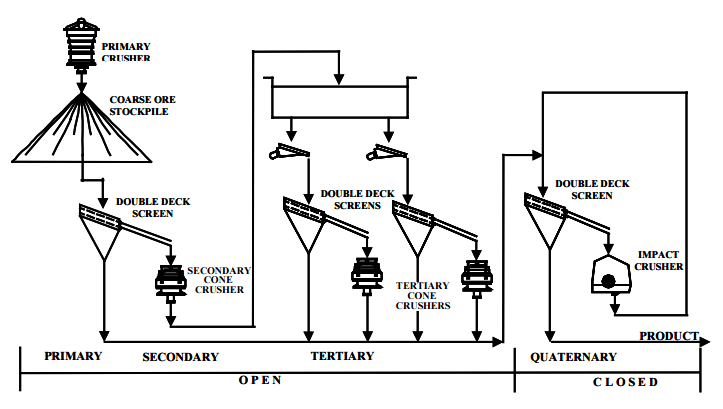When calculating the size of a crushing plant, it is not advisable to design a crushing plant to run for 24 hours per day. The machines are subjected to greater shocks and rougher wear than grinding and concentrating machinery and need more frequent attention in consequence. It is an almost universal custom to crush the daily mine output in one or two eight-hour shifts so as to have enough time available for inspection and any necessary repairs. The fact that crushing machines can be started and stopped without loss of time makes this arrangement possible; within a few minutes of being started they will be working at full capacity.
The question of whether the plant should be run for eight or sixteen hours per day depends chiefly on the character of the mining operations ; it is influenced by the fact that it is not advisable to provide much bin storage for coarse ore on account of the tendency of large lumps to pack and bridge over the discharge opening under the pressure of a heavy column of ore and to jam in the gate as well. When the common practice is followed of hoisting the mine output in one shift, it is usual, therefore, to crush it also in one shift.
There are occasions, however, when mining operations do not have the same influence, such, for instance, as when the ore has to be transported in trains which may arrive at intervals over a period of twelve hours or more. A certain amount of extra storage would have to be provided in a case like this and so the advisability of running two crushing shifts should have serious consideration. The question usually resolves itself into one of running versus capital costs. Up to an output of 2,000 tons per day the running cost of a plant crushing the ore in eight hours is generally less than that of one doing it in two shifts. The reason is that each stage of crushing can be performed in a single machine. Consequently, since one man can look after a large machine just as well as a small one, the number of men required to run one shift in a large plant is half the number needed for two shifts in a plant of half the hourly capacity, although the daily output in both cases is the same. Moreover, the efficiency of a single machine as it affects power consumption increases up to a capacity of about 250 tons per hour, so that the larger plant should also show an economy in power costs. The total direct cost of crushing 2,000 tons in eight hours is generally about 3½d. per ton, while in a smaller plant of half the hourly capacity it amounts to about 4d. per ton.
This saving of ½d. per ton is offset by the fact that the capital cost of the larger installation will be approximately 50% more than that of the smaller one. The charge for interest and depreciation, assuming that the capital cost is paid off in five years, works out on a cost per ton basis at 1½d. for the larger and 1d. for the smaller plant. Thus the saving in the running cost is balanced by the increase in interest and depreciation charges.
As a general rule, below a daily output of 2,000 tons, the larger plant handling the tonnage in one shift is likely to show a lower total cost because the saving in direct costs will exceed the increased charges for interest and depreciation; for plants exceeding this daily capacity the reverse usually holds good. In cases where there seems to be no advantage either way, it is, as a general rule, better to instal a plant to crush the tonnage in eight hours ; it is especially desirable when labour is expensive, since men on shiftwork are not as efficient as day workers and are more liable to sickness.
In many installations the daily tonnage is crushed in a day shift of ten hours, but this is not good policy unless it happens to be the local custom. The plant should be designed to do its work in eight hours. Then, if extra crushing capacity is required and local conditions permit a ten-hour working day, the excess tonnage can be handled without additional machinery. Many plants crushing on a ten-hour basis are doing it for this reason.

